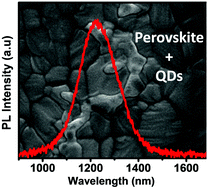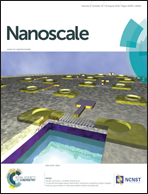Single step deposition of an interacting layer of a perovskite matrix with embedded quantum dots†
Abstract
Hybrid lead halide perovskite (PS) derivatives have emerged as very promising materials for the development of optoelectronic devices in the last few years. At the same time, inorganic nanocrystals with quantum confinement (QDs) possess unique properties that make them suitable materials for the development of photovoltaics, imaging and lighting applications, among others. In this work, we report on a new methodology for the deposition of high quality, large grain size and pinhole free PS films (CH3NH3PbI3) with embedded PbS and PbS/CdS core/shell Quantum Dots (QDs). The strong interaction between both semiconductors is revealed by the formation of an exciplex state, which is monitored by photoluminescence and electroluminescence experiments. The radiative exciplex relaxation is centered in the near infrared region (NIR), ≈1200 nm, which corresponds to lower energies than the corresponding band gap of both perovskite (PS) and QDs. Our approach allows the fabrication of multi-wavelength light emitting diodes (LEDs) based on a PS matrix with embedded QDs, which show considerably low turn-on potentials. The presence of the exciplex state of PS and QDs opens up a broad range of possibilities with important implications in both LEDs and solar cells.


 Please wait while we load your content...
Please wait while we load your content...